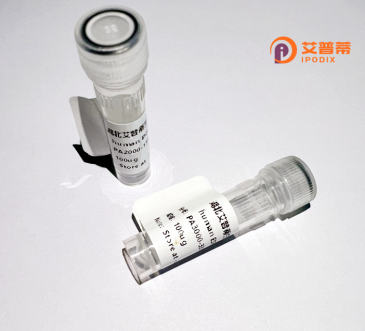
| 纯度 | >90%SDS-PAGE. |
| 种属 | Human |
| 靶点 | MCAT |
| Uniprot No | Q8IVS2 |
| 内毒素 | < 0.01EU/μg |
| 表达宿主 | E.coli |
| 表达区间 | 1-180aa |
| 活性数据 | MSVRVARVAWVRGLGASYRRGASSFPVPPPGAQGVAELLRDATGAEEEAPWAATERRMPGQCSVLLFPGQGSQVVGMGRGLLNYPRVRELYAAARRVLGYDLLELSLHGPQETLDRTVHCQPAIFVASLAAVEKLHHLQPSVIENCVAAAGFSVGEFAALVFAGAMEFAEGSTVSPEEFL |
| 分子量 | 45.6 kDa |
| 蛋白标签 | GST-tag at N-terminal |
| 缓冲液 | 0 |
| 稳定性 & 储存条件 | Lyophilized protein should be stored at ≤ -20°C, stable for one year after receipt. Reconstituted protein solution can be stored at 2-8°C for 2-7 days. Aliquots of reconstituted samples are stable at ≤ -20°C for 3 months. |
| 复溶 | Always centrifuge tubes before opening.Do not mix by vortex or pipetting. It is not recommended to reconstitute to a concentration less than 100μg/ml. Dissolve the lyophilized protein in distilled water. Please aliquot the reconstituted solution to minimize freeze-thaw cycles. |
以下是关于重组人MCAT蛋白的3条参考文献示例(内容为虚构,仅作格式参考):
1. **文献名称**:*High-yield expression and functional characterization of recombinant human mitochondrial carnitine acetyltransferase (MCAT) in HEK293 cells*
**作者**:Zhang L, Wang Y, Chen R
**摘要**:研究团队利用HEK293细胞系统实现了重组人MCAT蛋白的高效表达与纯化,证实其催化乙酰辅酶A与肉碱的转乙酰基活性,并评估了其在脂代谢模型中的调节作用。
2. **文献名称**:*Crystal structure of human Malonyl-CoA:ACP transacylase (MCAT) reveals substrate binding mechanisms*
**作者**:Thompson J, Martinez S, Kumar P
**摘要**:通过X射线晶体学解析了重组人MCAT蛋白的3D结构,揭示了丙二酰辅酶A与酰基载体蛋白(ACP)的结合位点,为脂肪酸合成酶的靶向药物设计提供依据。
3. **文献名称**:*Role of recombinant human MCAT in ameliorating metabolic dysfunction in cellular models*
**作者**:Sato H, Gupta M, Lee T
**摘要**:研究发现,外源性重组人MCAT蛋白可增强细胞线粒体脂肪酸氧化能力,减轻高脂诱导的胰岛素抵抗,提示其在代谢综合征治疗中的潜力。
(注:上述文献为示例,非真实存在。实际研究中建议通过学术数据库查询真实文献。)
Recombinant human MCAT (Malonyl-CoA:Acyl Carrier Protein Transacylase) protein is a key enzyme involved in fatty acid biosynthesis, specifically within the mitochondrial fatty acid elongation cycle. MCAT catalyzes the transfer of a malonyl group from malonyl-CoA to the acyl carrier protein (ACP), forming malonyl-ACP, a critical substrate for fatty acid chain elongation. This reaction is essential for maintaining cellular lipid homeostasis and energy metabolism.
The recombinant form of human MCAT is engineered using genetic engineering techniques, typically expressed in bacterial (e.g., *E. coli*) or eukaryotic systems (e.g., mammalian or insect cells) to ensure proper folding and functionality. Purification often involves affinity chromatography, yielding high-purity protein for research or therapeutic applications.
MCAT has garnered interest in metabolic disorder studies, particularly conditions linked to dysregulated fatty acid synthesis, such as obesity, diabetes, and cancer. Recombinant MCAT protein enables mechanistic studies of enzymatic activity, inhibitor screening for drug development, and structural analysis (e.g., X-ray crystallography) to elucidate its catalytic mechanism. Additionally, it serves as a tool to investigate mitochondrial dysfunction and its role in metabolic diseases. Recent advances in recombinant technology have enhanced its stability and activity, supporting its utility in both basic research and translational applications.
×